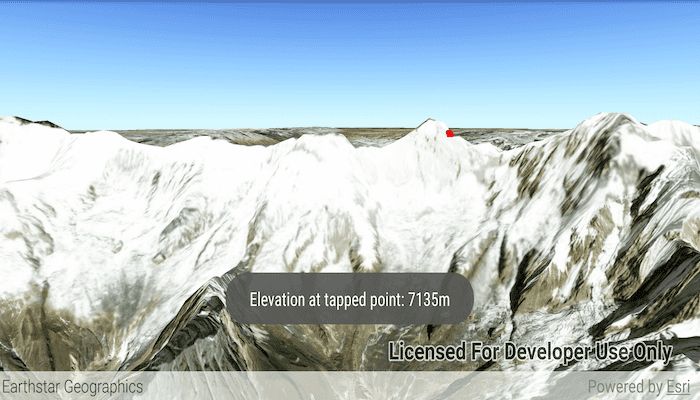Get the elevation for a given point on a surface in a scene.

Use case
Knowing the elevation at a given point in a landscape can aid in navigation, planning and survey in the field.
How to use the sample
Tap anywhere on the surface to get the elevation at that point. Elevation is reported in meters since the scene view is in WGS84.
How it works
- Create a
SceneViewandScenewith an imagery base map. - Set an
ArcGISTiledElevationSourceas the elevation source of the scene's base surface. - Use the
screenToBaseSurface(screenPoint)method on the scene view to convert the tapped screen point into a point on surface. - Use the
getElevationAsync(surfacePoint)method on the base surface to asynchronously get the elevation.
Relevant API
- ArcGISTiledElevationSource
- BaseSurface
- ElevationSourcesList
- SceneView
Additional information
getElevationAsync(surfacePoint) retrieves the most accurate available elevation value at a given point. To do this, the method must go to the server or local raster file and load the highest level of detail of data for the target location and return the elevation value.
If multiple elevation sources are present in the surface, the top most visible elevation source with a valid elevation in the given location is used to determine the result.
Tags
elevation, MapViews SceneViews and UI, surface
Sample Code
/* Copyright 2019 Esri
*
* Licensed under the Apache License, Version 2.0 (the "License");
* you may not use this file except in compliance with the License.
* You may obtain a copy of the License at
*
* http://www.apache.org/licenses/LICENSE-2.0
*
* Unless required by applicable law or agreed to in writing, software
* distributed under the License is distributed on an "AS IS" BASIS,
* WITHOUT WARRANTIES OR CONDITIONS OF ANY KIND, either express or implied.
* See the License for the specific language governing permissions and
* limitations under the License.
*
*/
package com.esri.arcgisruntime.sample.getelevationatpoint;
import java.util.concurrent.ExecutionException;
import android.graphics.Color;
import android.os.Bundle;
import androidx.appcompat.app.AppCompatActivity;
import android.util.Log;
import android.view.MotionEvent;
import android.widget.Toast;
import com.esri.arcgisruntime.ArcGISRuntimeEnvironment;
import com.esri.arcgisruntime.concurrent.ListenableFuture;
import com.esri.arcgisruntime.geometry.Point;
import com.esri.arcgisruntime.mapping.ArcGISScene;
import com.esri.arcgisruntime.mapping.ArcGISTiledElevationSource;
import com.esri.arcgisruntime.mapping.Basemap;
import com.esri.arcgisruntime.mapping.BasemapStyle;
import com.esri.arcgisruntime.mapping.view.Camera;
import com.esri.arcgisruntime.mapping.view.DefaultSceneViewOnTouchListener;
import com.esri.arcgisruntime.mapping.view.Graphic;
import com.esri.arcgisruntime.mapping.view.GraphicsOverlay;
import com.esri.arcgisruntime.mapping.view.SceneView;
import com.esri.arcgisruntime.symbology.SimpleMarkerSymbol;
public class MainActivity extends AppCompatActivity {
private static final String TAG = MainActivity.class.getSimpleName();
private SceneView mSceneView;
@Override
protected void onCreate(Bundle savedInstanceState) {
super.onCreate(savedInstanceState);
setContentView(R.layout.activity_main);
// authentication with an API key or named user is required to access basemaps and other
// location services
ArcGISRuntimeEnvironment.setApiKey(BuildConfig.API_KEY);
// create a scene and add a basemap to it
ArcGISScene scene = new ArcGISScene(BasemapStyle.ARCGIS_IMAGERY);
// get a reference to the scene view and set the scene to it
mSceneView = findViewById(R.id.sceneView);
mSceneView.setScene(scene);
// create an elevation source, and add this to the base surface of the scene
ArcGISTiledElevationSource elevationSource = new ArcGISTiledElevationSource(
getString(R.string.elevation_image_service));
scene.getBaseSurface().getElevationSources().add(elevationSource);
// create a point symbol to mark where elevation is being measured
SimpleMarkerSymbol circleSymbol = new SimpleMarkerSymbol(SimpleMarkerSymbol.Style.CIRCLE, Color.RED, 10);
// create a graphics overlay
GraphicsOverlay graphicsOverlay = new GraphicsOverlay(GraphicsOverlay.RenderingMode.DYNAMIC);
mSceneView.getGraphicsOverlays().add(graphicsOverlay);
// add a camera and initial camera position
Camera camera = new Camera(28.42, 83.9, 10000.0, 10.0, 80.0, 0.0);
mSceneView.setViewpointCamera(camera);
// create a touch listener to handle taps
mSceneView.setOnTouchListener(new DefaultSceneViewOnTouchListener(mSceneView) {
@Override public boolean onSingleTapConfirmed(MotionEvent motionEvent) {
// clear any existing graphics from the graphics overlay
graphicsOverlay.getGraphics().clear();
// get the tapped screen point
android.graphics.Point screenPoint = new android.graphics.Point(Math.round(motionEvent.getX()),
Math.round(motionEvent.getY()));
// convert the screen point to a point on the surface
Point surfacePoint = mSceneView.screenToBaseSurface(screenPoint);
if (surfacePoint == null) {
Toast.makeText(MainActivity.this, "Cannot get an elevation for a point which is not on the surface.",
Toast.LENGTH_SHORT).show();
return super.onSingleTapConfirmed(motionEvent);
}
// create a new graphic at the surface point and add it to the graphics overlay
Graphic surfacePointGraphic = new Graphic(surfacePoint, circleSymbol);
graphicsOverlay.getGraphics().add(surfacePointGraphic);
// get the surface elevation at the surface point
ListenableFuture<Double> elevationFuture = scene.getBaseSurface().getElevationAsync(surfacePoint);
elevationFuture.addDoneListener(() -> {
try {
Double elevation = elevationFuture.get();
String elevationMessage = "Elevation at tapped point: " + Math.round(elevation) + 'm';
Toast.makeText(MainActivity.this, elevationMessage, Toast.LENGTH_LONG).show();
Log.i(TAG, elevationMessage);
} catch (ExecutionException | InterruptedException e) {
String error = "Error getting elevation: " + e.getMessage();
Toast.makeText(MainActivity.this, error, Toast.LENGTH_LONG).show();
Log.e(TAG, error);
}
});
return super.onSingleTapConfirmed(motionEvent);
}
});
}
@Override
protected void onPause() {
mSceneView.pause();
super.onPause();
}
@Override
protected void onResume() {
super.onResume();
mSceneView.resume();
}
@Override protected void onDestroy() {
mSceneView.dispose();
super.onDestroy();
}
}